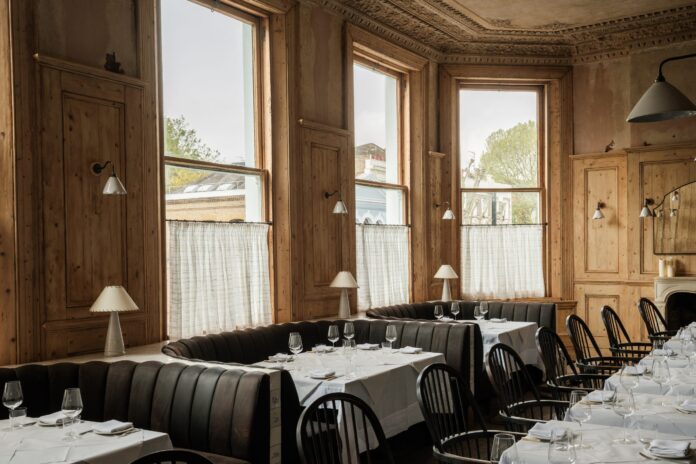It feels as though, in recent years, Nepali food has experienced a well-deserved surge in popularity in the UK.
In 2019, the Nepali Times predicted Nepali cuisine was about to ‘go global’, and so it has come to pass, at least in this small corner of the world.
Momo trucks have become increasingly ubiquitous at festivals across the UK. A fine-dining iteration of the country’s cuisine is due to open in Fitzrovia later in the year following an appearance on Million Dollar Menu. And in 2020, MasterChef: The Professionals saw one of its most popular ever contestants, the London-based Nepali chef Santosh Shah, reach the final.
But if you’re going to try this diverse, delicious cuisine first-hand and at its finest, then you simply have to go to the source. The rich and diverse Nepali gastronomy, influenced by traditional Indian, Tibetan, and Chinese elements, offers a heady, intoxicating blend of spices, flavours and textures that you won’t find anywhere else on the planet.
So, whether you’re visiting Nepal to scale Everest or get spiritual, don’t miss out on the chance to savour these local dishes, ones that perfectly encapsulate the spirit of Nepali culinary heritage. Here are 9 local dishes to try on your holiday to Nepal.
Dal Bhat
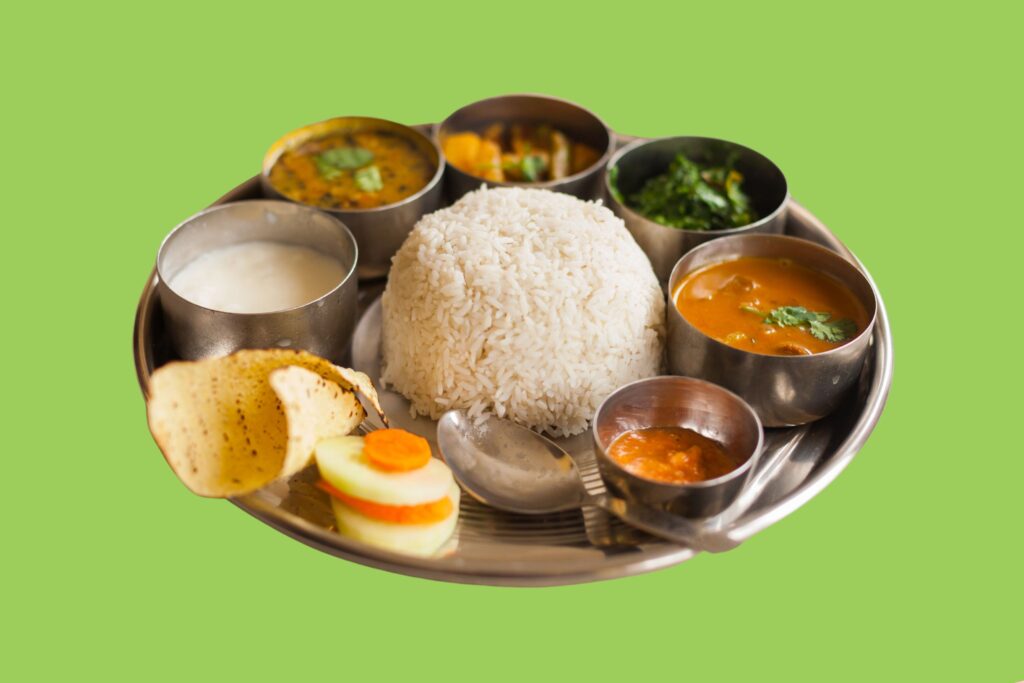
No trip to Nepal is complete without tasting the quintessential Nepali platter of Dal Bhat. This staple meal, enjoyed twice a day – typically in the mid-morning and then the evening – by most Nepalis, consists of steamed rice (bhat) served with a hearty lentil soup (dal), accompanied by a variety of vegetable curries, pickle (achar), and sometimes meat. The dish’s simplicity belies its satisfying and comforting nature – perfect for providing the energy required for treks through the Himalayas.
There is a huge variety of Dal Bhat eaten across the country. Just a few of the most popular include:
- Classic Dal Bhat Tarkari: This is the most common form of Dal Bhat, which includes rice, lentil soup, and a vegetable curry (tarkari). The dal can be made from various lentils like pigeon peas (arhar), black lentils (masoor), or mung beans (mung daal). Tarkari often consists of seasonal vegetables like spinach, cauliflower, or potatoes cooked with spices and herbs.
- Dal Bhat with Saag: In this version of Dal Bhat, the meal is accompanied by saag, which is a leafy green vegetable dish. Saag can be made from spinach, mustard greens, or other green leafy vegetables. It is usually sautéed with garlic, ginger, and spices, then served alongside the traditional lentil soup and rice.
- Pahadi Dal Bhat: This is a popular variation in the hilly regions of Nepal. Pahadi Dal Bhat features a unique combination of rice, lentil soup, and side dishes like gundruk (fermented leafy greens), kinima (fermented soybean), and other locally available vegetables.
- Newari Dal Bhat: The Newari community in Nepal has their own unique twist on Dal Bhat. It is often served with flattened rice (chiura) instead of steamed rice and accompanied by a variety of side dishes like spicy vegetables, pickles, and offal meat dishes.
- Thakali Dal Bhat: Thakali Dal Bhat has its origins among the Thakali community in the Mustang district of Nepal. This variation includes rice, black lentil soup, and a wide range of side dishes, such as marinated meat, spicy potatoes, and gundruk. It is typically served with a tomato-based pickle, achaar, for additional flavour.
Momos
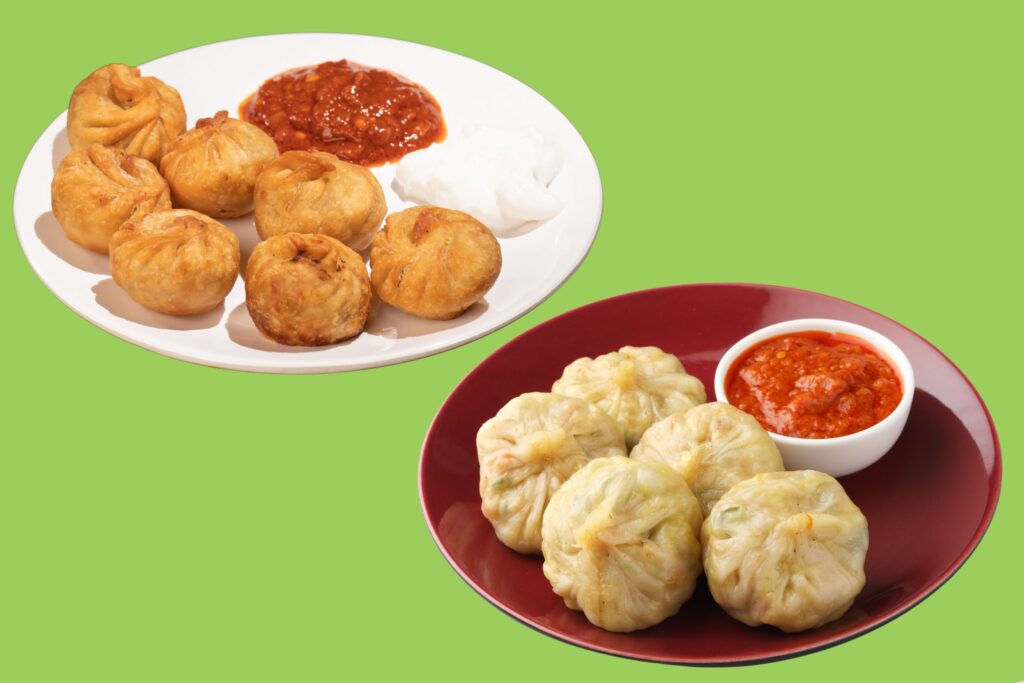
Arguably Nepal’s most well-known national dish on these shores, Momos are tantalising Nepali dumplings that have become a beloved street food throughout the nation. Made by filling thin dough with various ingredients such as minced meat (chicken, buff, or pork), vegetables, or cheese, they are then either steamed or fried to perfection. Dip these flavourful bundles of joy in a tangy tomato-based achaar, and you have a heavenly treat that’s hard to resist.
On your holiday to Nepal, it’s pretty much obligatory you try these versions of momo, at the very least:
- Steamed Momo: Also known as Bhutuwa momo, these are the most common type of momo. The dough is filled with a mixture of minced meat (chicken, pork, or buffalo) or vegetables, and then steamed. The momos are served with a side of achaar.
- Kothey Momo: Kothey momos are a hybrid between steamed and fried momos. They are first steamed and then pan-fried on one side, resulting in a golden crisp texture on the fried side while maintaining a soft, steamed texture on the other.
- C-Momo: This rendition of momo is served in a hot, spicy, and slightly thick sauce. The steamed momos are stir-fried with a generous amount of sauce made from tomatoes, garlic, ginger, and chilli pepper, creating a flavorful, saucy dish.
- Jhol Momo: Jhol momo features steamed momos immersed in a thin, flavorful, and mildly spicy Jhol Achaar sauce. This tomato-based sauce is seasoned with a mixture of spices, sesame seeds, and ground peanuts, giving the momos a tangy and nutty taste.
- Tandoori Momo: Inspired by Indian tandoori cooking, tandoori momo are marinated with yoghurt and spices like cumin, coriander, and garam masala, then grilled or baked in a tandoor oven or regular oven. This gives the momo a smoky, charred flavour and unique texture.
- Chatamari Momo: In this fusion variation, momo fillings such as minced meat or vegetables are wrapped in a thin and crispy rice flour-based pancake (chatamari) instead of the usual dough. Chatamari momo combine the flavours of two popular Nepali dishes: momo and chatamari.
Read: Where to eat in Bath City centre
Thukpa

A warm bowl of Thukpa is perfect after a chilly day spent trekking in the Nepalese mountains. This cosy noodle soup, with Tibetan origins, combines succulent pieces of meat (most often marinated chicken, goat or yak meat), vegetables, and noodles in a flavorful broth. Infused with local spices, Thukpa is both comforting and invigorating, making it a favourite among trekkers and locals alike.
You’ll often find vegetarian versions, too, that deploy tofu or paneer. Just delicious.
Sel Roti
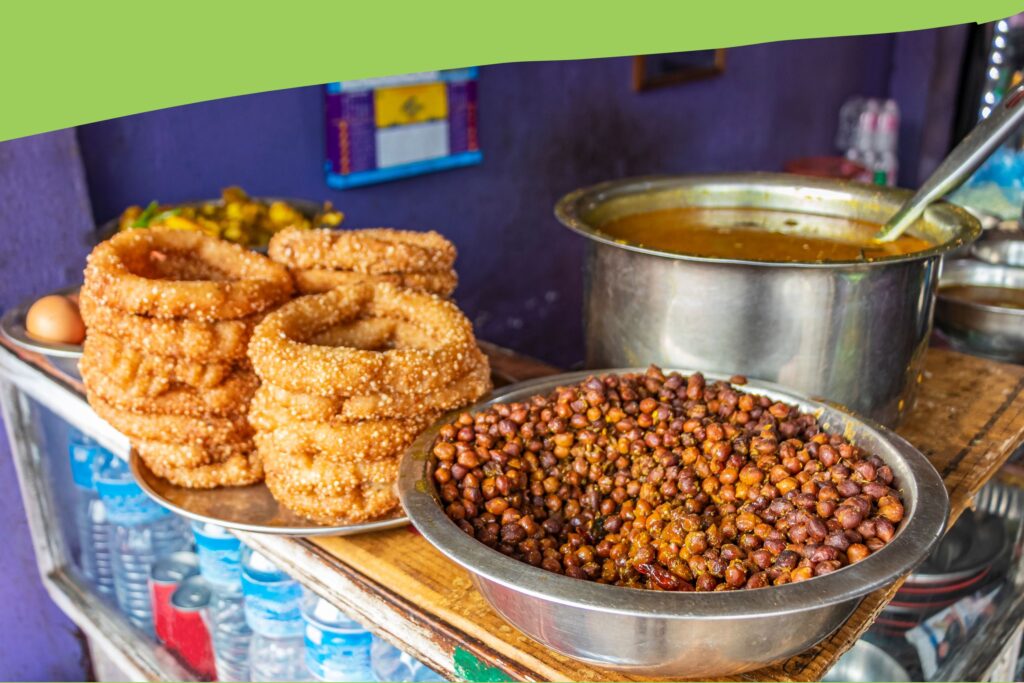
Sel Roti is a unique deep-fried rice flour ring that is both crunchy and fluffy. It is a traditional homemade sweet and is commonly consumed during Nepali festivals like Dashain and Tihar (Diwali). Often eaten with a side of yoghurt, tea, or curry, Sel Roti offers a delightful experience for those with a sweet tooth.
Dhido

A traditional and nutritious alternative to rice, Dhido is a thick porridge made by continuously stirring a mixture of water and either cornmeal or millet flour until it thickens. This mountain staple is typically consumed with a side of vegetable curry, pickle (achar) or spicy gundruk soup (fermented leafy green). Don’t miss the chance to appreciate this earthy and fulfilling dish when visiting rural areas of Nepal.
To make your own at home, you’ll need:
- 2 cups of millet, corn, or wheat flour (depending on your preference)
- 4 cups of water
- A pinch of salt
- 1 tablespoon of ghee or oil (optional)
Here’s what to do:
- Boil the water in a large pot. Add a pinch of salt to taste.
- When the water comes to a rolling boil, slowly add the flour to the pot while continuously stirring with a wooden spoon. Make sure to avoid forming any lumps.
- Keep stirring the mixture continuously to avoid sticking to the bottom of the pot. The dhido should start thickening as you cook it.
- Lower the heat once the mixture begins to come together. At this point, if you prefer a creamier consistency, you can add ghee or oil.
- Cook for another 10-15 minutes while continuously stirring, ensuring it doesn’t stick to the bottom. The dhido is ready when it becomes thick, shiny, and forms a dough-like consistency.
- To serve, wet your hands with water and carefully scoop out a portion of the hot dhido. Roll it into a ball and flatten it slightly. Place it on a serving plate and repeat the process for the remaining dhido.
- Enjoy Nepali Dhido with your choice of accompaniments, such as vegetable curry, lentil soup (dal), or yoghurt.
Some variations of dhido may also include spices mixed into the dough, like cumin seeds or turmeric powder for added flavour and colour. You can experiment with adding different spices or ingredients to personalise the dish to your taste.
Choila
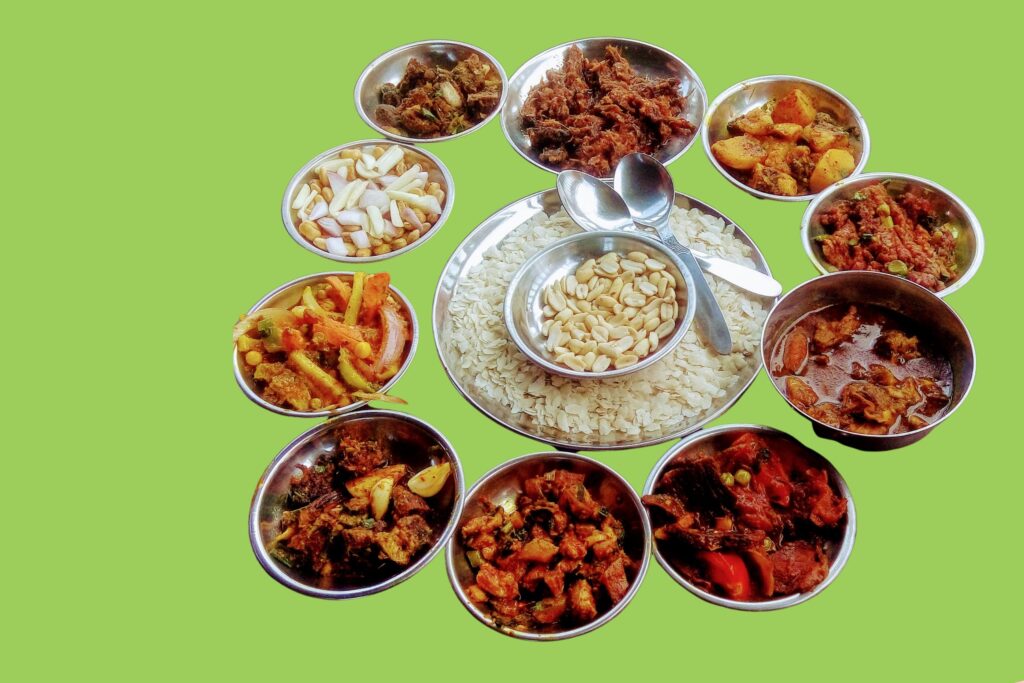
Originating from the Newari community, Choila is a spicy grilled meat dish that is delicately spiced and with just the right amount of bite (many Nepali prefer their grilled meats to have a pleasing chewiness).
Traditionally prepared using water buffalo meat, modern variations of the dish also feature chicken or duck. Marinated with a spice mix containing cumin, garlic, ginger, turmeric, and coriander, Choila is enjoyed with chiura (beaten rice) and an array of other Newari side dishes.
Yomari
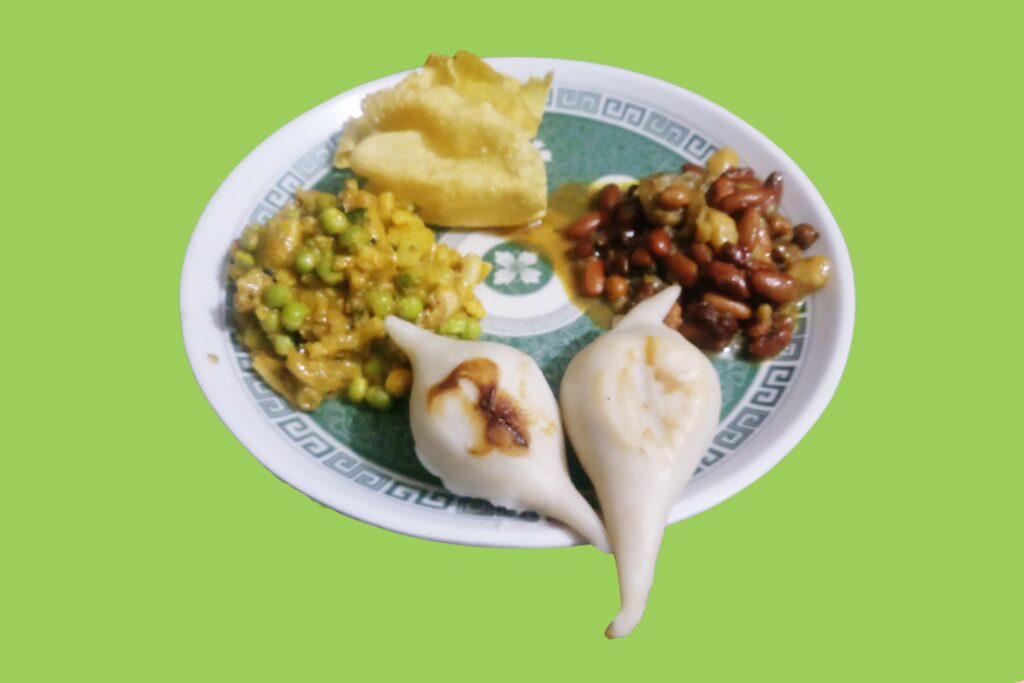
Yomari is an exquisite Newari delicacy typically prepared during the Yomari Punhi festival. Made from rice flour dough, these sweet dumplings are filled with a mixture of chaku (cane sugar) and khoa (clarified milk solids). Shaped like a fish, these sweet treats hold a special cultural significance and offer a delightful glimpse into the rich culinary heritage of Nepal.
The festival of Yomari Punhi’s importance cannot be overstated. Here, people prepare and enjoy Yomari in the Newar community. Celebrated during the winter months, Yomari Punhi marks the end of the rice harvest season and is a way to express gratitude to gods and goddesses for the good harvest. On this day, people also exchange Yomari as gifts, symbolising love and friendship.
According to local mythology, Yomari was first made by a couple from Panauti – a small town in Nepal – who offered it to the gods. As the gods were pleased, they blessed the couple, and the tradition of making Yomari began. It reflects the significance of food offerings in Nepali culture and the belief in divine blessings. Family members often come together to prepare Yomari, creating a wonderful sense of community.
Read: The best places to eat in Balham
Chatamari
Often referred to as ‘Nepali pizza’, Chatamari is another Newari speciality well worth savouring. It is a thin, round rice flour crepe topped with minced meat, vegetables, and spices, cooked to crisp perfection on a flat pan. This versatile dish can also be enjoyed as a meal or a snack, and pairs particularly well with a hot, sweet and milky chiya tea, lassi, or even raksi, a locally brewed rice spirit. Do go easy with the latter, though; it’s strong!
Juju Dhau
Translated as ;King of Yogurt’, Juju Dhau is a creamy and delightful dessert hailing from the ancient city of Bhaktapur. It’s made by setting fresh buffalo milk sweetened with sugar inside a clay pot. The unique method and environment lend it a distinct flavour and texture that represents the perfect closing act to your trip (and our article) to Nepal.



